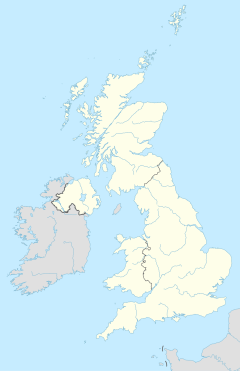
Taxus is a genus of coniferous trees or shrubs known as yews in the family Taxaceae. Yews occur around the globe in temperate zones of the northern hemisphere, northernmost in Norway and southernmost in the South Celebes. Some populations exist in tropical highlands.

Taxus baccata is a species of evergreen tree in the family Taxaceae, native to Western Europe, Central Europe and Southern Europe, as well as Northwest Africa, northern Iran, and Southwest Asia. It is the tree originally known as yew, though with other related trees becoming known, it may be referred to as common yew, European yew, or in North America English yew. It is a woodland tree in its native range, and it's also grown as an ornamental tree, hedge or topiary. Most parts of the plant are poisonous, with toxins that can be absorbed through inhalation, ingestion and through the skin; consumption of even a small amount of the foliage can result in death.

Taxus cuspidata, the Japanese yew or spreading yew, is a member of the genus Taxus, native to Japan, Korea, northeast China and the extreme southeast of Russia.
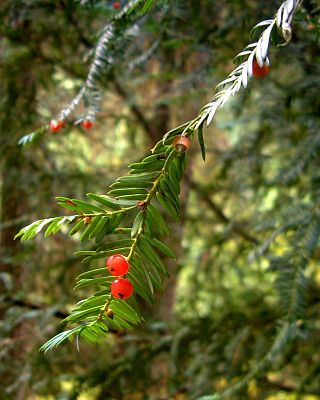
Taxus brevifolia, the Pacific yew or western yew, is a species of tree in the yew family Taxaceae native to the Pacific Northwest of North America. It is a small evergreen conifer, thriving in moisture and otherwise tending to take the form of a shrub.
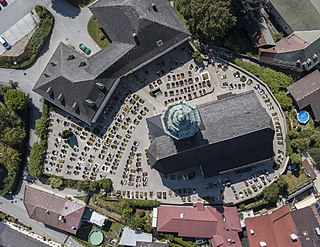
In Christian countries a churchyard is a patch of land adjoining or surrounding a church, which is usually owned by the relevant church or local parish itself. In the Scots language and in both Scottish English and Ulster Scots, this can also be known as a kirkyard.
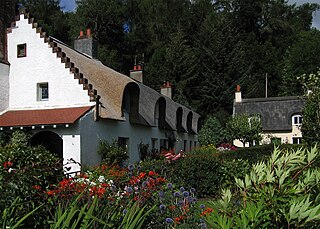
Fortingall is a small village in Glen Lyon, Perthshire, Scotland. Its nearest sizable neighbours are Aberfeldy and Kenmore.

Methuselah is a 4,855-year-old Great Basin bristlecone pine tree growing high in the White Mountains of Inyo County in eastern California. It is recognized as the non-clonal tree with the greatest confirmed age in the world. The tree's name refers to the biblical patriarch Methuselah, who is said to have reached 969 years of age before his death, thus becoming synonymous with longevity or old age in many European languages including English.

Taxus floridana, the Florida yew, is a species of yew, endemic to a small area of under 10 km² on the eastern side of the Apalachicola River in mesophytic forests of northern Florida at altitudes of 15–40 m. It is listed as critically endangered. It is protected in reserves at the Torreya State Park and at the Nature Conservancy's Apalachicola Bluffs and Ravines Preserve, and has legal protection under the United States and Florida Endangered Species laws.

The flora of Scotland is an assemblage of native plant species including over 1,600 vascular plants, more than 1,500 lichens and nearly 1,000 bryophytes. The total number of vascular species is low by world standards but lichens and bryophytes are abundant and the latter form a population of global importance. Various populations of rare fern exist, although the impact of 19th-century collectors threatened the existence of several species. The flora is generally typical of the north-west European part of the Palearctic realm and prominent features of the Scottish flora include boreal Caledonian forest, heather moorland and coastal machair. In addition to the native species of vascular plants there are numerous non-native introductions, now believed to make up some 43% of the species in the country.
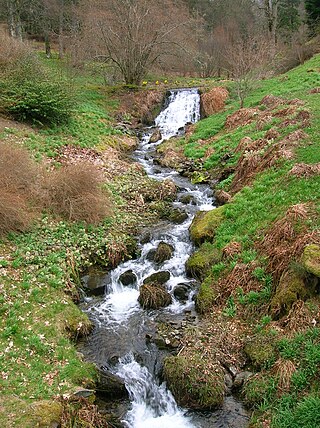
Dawyck Botanic Garden is a botanic garden and arboretum covering 25 hectares at Stobo on the B712, 8 miles south of Peebles in the Scottish Borders region of Scotland, OS ref. NT168352. The garden is situated in the Upper Tweed Valley, a National Scenic Area.
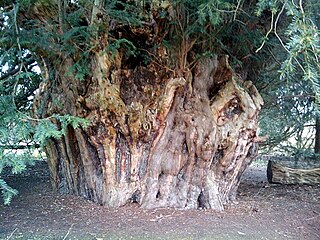
The Ankerwycke Yew is an ancient yew tree close to the ruins of St Mary's Priory, the site of a Benedictine nunnery built in the 12th century, near Wraysbury in Berkshire, England. It is a male tree with a girth of 8 metres (26 ft) at 0.3 metres. The tree is at least 1,400 years old, and could be as old as 2,500 years.

The Llangernyw Yew ( ) is an ancient yew in the village of Llangernyw, Conwy, Wales. The tree is fragmented and its core part has been lost, leaving several enormous offshoots. The girth of the tree at the ground level is 10.75 m (35.3 ft).

Bermiego Yew, also called in Asturias "Teixu l'Ilesia" is an ancient tree of the species Taxus baccata growing in the village of Bermiego in the Principality of Asturias, northern Spain on the western slope of the Sierra del Aramo. The tree can be found just outside the village within the precincts of the village chapel of Santa Maria de Bermiego.
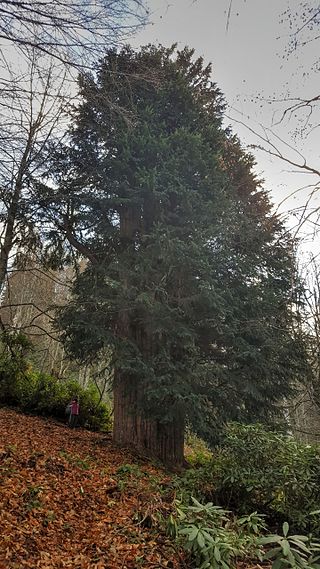
Gümeli Porsuğu is a yew tree growing high in Zonguldak district of Black Sea Region, in Turkey. It is estimated to be 4,115 years old.

The Craigends Yew (NS4199566134) is an ancient European layering yew growing next to the River Gryffe in what were the grounds of the Craigends Estate, Houston in Renfrewshire, Scotland. Estimates put its age at around 500 to 700 years old and it is one of the largest and oldest examples of a heritage layering yew in Scotland.

The Ashbrittle Yew is an ancient yew tree located in the village of Ashbrittle, Somerset, in southwest England. The yew grows on a tumulus in the south-east end of the churchyard of St. John the Baptist. Yews are capable of living for several thousands of years; the Ashbrittle Yew itself is believed to be over 3,000 years old, but defining its precise age is difficult due to its hollow centre. The tree is formed of a hollow central trunk surrounded by six narrower boles. In 2015 its measured diameter was 39'11".

The Defynnog Yew (SN9253027960) is one of a group of ancient yews in the churchyard of St Cynog's Church, which serves the parish and the village of Defynnog, Powys, Wales. Defynnog is located close to Sennybridge, about ten miles west of Brecon, within the Brecon Beacons National Park.

